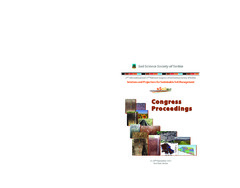Приказ основних података о документу
Land degradation neutrality in Serbia
| dc.creator | Zivotic, Ljubomir | |
| dc.creator | Golubović, Slađana | |
| dc.creator | Radmanović, Svjetlana | |
| dc.creator | Belić, Milivoj | |
| dc.creator | Đorđević, Aleksandar | |
| dc.date.accessioned | 2024-01-11T09:05:30Z | |
| dc.date.available | 2024-01-11T09:05:30Z | |
| dc.date.issued | 2017 | |
| dc.identifier.isbn | 978-86-912877-1-9 | |
| dc.identifier.uri | http://aspace.agrif.bg.ac.rs/handle/123456789/6751 | |
| dc.description.abstract | Land degradation neutrality (LDN) is defined as a state whereby the amount and quality of land resources necessary to support ecosystem functions and services and enhance food security remain stable or increase within specified temporal and spatial scales. This concept is a part of sustainable development goal 15 of the UN Agenda for Sustainable Development. Target 15.3 aims to combat desertification, restore degraded land and soil, including land affected by desertification, drought and floods, and strive to achieve a land degradation-neutral world by 2030. The achievement of this target is measured through indicator called “Proportion of land that is degraded over total land area”. United Nations Convention to Combat Desertification (UNCCD) endorsed SDG target 15.3 and the concept of land degradation neutrality as a strong vehicle for the implementation of the Convention. Countries are invited to formulate voluntary targets to achieve LDN. UNCCD provide guidance for formulating national voluntary targets and facilitate utilization of the UNCCD indicator framework. Republic of Serbia has ratified Convention in 2007 and actively works on LDN target setting process. This paper aims to present: (a) the basic principles of LDN concept, (b) global datasets provided by UNCCD, (c) SWOT analysis for the country, and (d) to discuss possible national datasets and further activities related to LDN. Indicator “Proportion of land that is degraded over total land area” is measured by means of three subindicators: land cover, land productivity and soil organic carbon. This indicator framework could be broaden with national indicators by decision of the country. Country has been provided by global data on land cover from European Space Agency (ESA). Land productivity dynamics (LPD) dataset was prepared by Joint Research Centre of the European Commission, while soil organic carbon (SOC) dataset was provided by ISRIC. Watershed boundaries are provided from FAO GAUL network. Net area change as a result of comparison between two periods for land covers change and SOC, while LPD is obtained as a trend for the 15 years period. ESA land cover data are given for the two epochs, around 2000 and 2010. These data indicate the loss of 3,800 ha of forests and their conversion to croplands or shrubs. National datasets on land cover exist but their utilization is constrained with the necessity to have dataset for two period of time and to have regular acquisition of future data which are necessary for further analysis and monitoring. Land productivity dynamics data indicated that 5% of the Serbian territory has negative trends in land productivity for the period 1998-2013. There are no national data on LPD obtained according to LDN concept. Soil organic carbon for the country indicates average content of 82.2 t/ha. National data on SOC stocks exist in the databases of relevant institutions but the problems in their utilization are related to the fact that they are sometimes very old, rarely geo-referenced, and obtained by various analytical and terrain procedures. Hence, global data on SOC stocks do not present real country situation, while national SOC stocks data should be systematized to be confident. Indicator analysis at watershed level has recognized the watersheds of Great Morava, Tisa, Sava 3 and South Morava and Nisava rivers, as four watersheds which present 50% of degraded areas according to the proposed methodology. These watersheds should be prone to detailed analysis of around 20 potential hotspots are found in the country. LDN baseline is not yet decided on a country level. Global land cover and land productivity dynamics data will be used until we obtain national data for these indicators. SOC national data should be systematized and used instead of global data. Further activities in LDN target setting process are related to the establishment of LDN baseline, analysis of land degradation trends and drivers, and suggestion of possible national voluntary targets and associated measures at the country, local and/or watershed level. The inclusion of national indicators should be further discussed. LDN concept should be strongly lead by the Government of Republic of Serbia. Hence, Serbian UNCCD NAP document should be finalized, adopted by the Government and LDN embedded into the NAP. | sr |
| dc.language.iso | en | sr |
| dc.publisher | Srpsko društvo za proučavanje zemljišta | sr |
| dc.rights | openAccess | sr |
| dc.rights.uri | https://creativecommons.org/licenses/by/4.0/ | |
| dc.source | 2nd International and 14th National Congress of Soil Science Society of Serbia "Solutions and Projections for Sustainable Soil Management", Novi Sad, Serbia | sr |
| dc.subject | LDN | sr |
| dc.subject | indicators | sr |
| dc.subject | soil degradation | sr |
| dc.subject | Serbia | sr |
| dc.title | Land degradation neutrality in Serbia | sr |
| dc.type | conferenceObject | sr |
| dc.rights.license | BY | sr |
| dc.citation.epage | 92 | |
| dc.citation.spage | 80 | |
| dc.identifier.fulltext | http://aspace.agrif.bg.ac.rs/bitstream/id/25699/bitstream_25699.pdf | |
| dc.identifier.rcub | https://hdl.handle.net/21.15107/rcub_agrospace_6751 | |
| dc.type.version | publishedVersion | sr |


